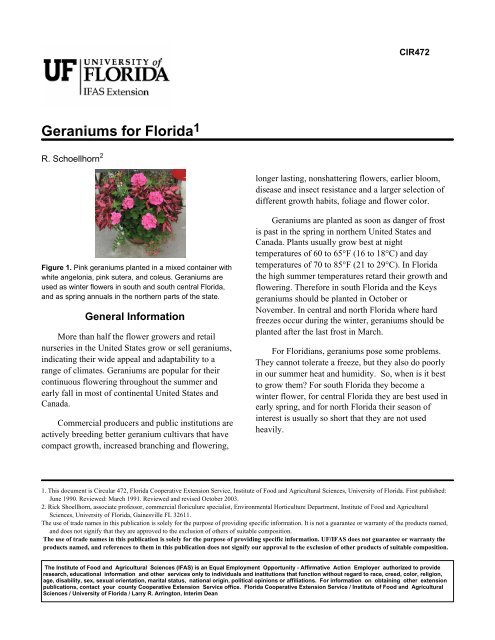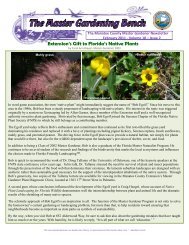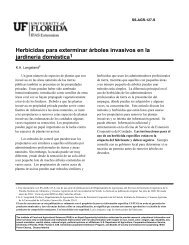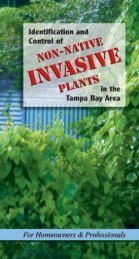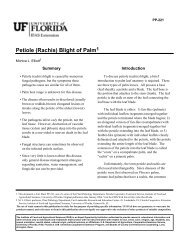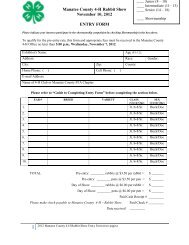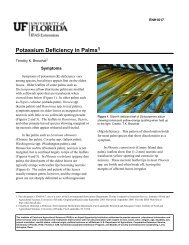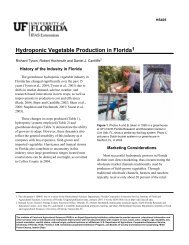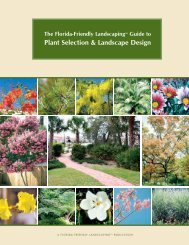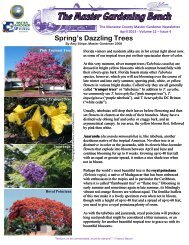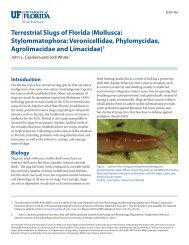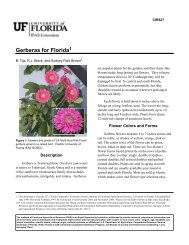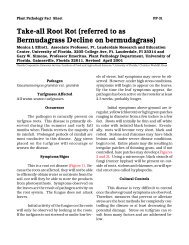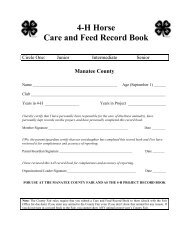Geraniums for Florida - Manatee County Extension Office ...
Geraniums for Florida - Manatee County Extension Office ...
Geraniums for Florida - Manatee County Extension Office ...
You also want an ePaper? Increase the reach of your titles
YUMPU automatically turns print PDFs into web optimized ePapers that Google loves.
CIR472<br />
<strong>Geraniums</strong> <strong>for</strong> <strong>Florida</strong> 1<br />
R. Schoellhorn 2<br />
longer lasting, nonshattering flowers, earlier bloom,<br />
disease and insect resistance and a larger selection of<br />
different growth habits, foliage and flower color.<br />
Figure 1. Pink geraniums planted in a mixed container with<br />
white angelonia, pink sutera, and coleus. <strong>Geraniums</strong> are<br />
used as winter flowers in south and south central <strong>Florida</strong>,<br />
and as spring annuals in the northern parts of the state.<br />
General In<strong>for</strong>mation<br />
More than half the flower growers and retail<br />
nurseries in the United States grow or sell geraniums,<br />
indicating their wide appeal and adaptability to a<br />
range of climates. <strong>Geraniums</strong> are popular <strong>for</strong> their<br />
continuous flowering throughout the summer and<br />
early fall in most of continental United States and<br />
Canada.<br />
Commercial producers and public institutions are<br />
actively breeding better geranium cultivars that have<br />
compact growth, increased branching and flowering,<br />
<strong>Geraniums</strong> are planted as soon as danger of frost<br />
is past in the spring in northern United States and<br />
Canada. Plants usually grow best at night<br />
temperatures of 60 to 65°F (16 to 18°C) and day<br />
temperatures of 70 to 85°F (21 to 29°C). In <strong>Florida</strong><br />
the high summer temperatures retard their growth and<br />
flowering. There<strong>for</strong>e in south <strong>Florida</strong> and the Keys<br />
geraniums should be planted in October or<br />
November. In central and north <strong>Florida</strong> where hard<br />
freezes occur during the winter, geraniums should be<br />
planted after the last frost in March.<br />
For Floridians, geraniums pose some problems.<br />
They cannot tolerate a freeze, but they also do poorly<br />
in our summer heat and humidity. So, when is it best<br />
to grow them? For south <strong>Florida</strong> they become a<br />
winter flower, <strong>for</strong> central <strong>Florida</strong> they are best used in<br />
early spring, and <strong>for</strong> north <strong>Florida</strong> their season of<br />
interest is usually so short that they are not used<br />
heavily.<br />
1. This document is Circular 472, <strong>Florida</strong> Cooperative <strong>Extension</strong> Service, Institute of Food and Agricultural Sciences, University of <strong>Florida</strong>. First published:<br />
June 1990. Reviewed: March 1991. Reviewed and revised October 2003.<br />
2. Rick Shoellhorn, associate professor, commercial floriculure specialist, Environmental Horticulture Department, Institute of Food and Agricultural<br />
Sciences, University of <strong>Florida</strong>, Gainesville FL 32611.<br />
The use of trade names in this publication is solely <strong>for</strong> the purpose of providing specific in<strong>for</strong>mation. It is not a guarantee or warranty of the products named,<br />
and does not signify that they are approved to the exclusion of others of suitable composition.<br />
The use of trade names in this publication is solely <strong>for</strong> the purpose of providing specific in<strong>for</strong>mation. UF/IFAS does not guarantee or warranty the<br />
products named, and references to them in this publication does not signify our approval to the exclusion of other products of suitable composition.<br />
The Institute of Food and Agricultural Sciences (IFAS) is an Equal Employment Opportunity - Affirmative Action Employer authorized to provide<br />
research, educational in<strong>for</strong>mation and other services only to individuals and institutions that function without regard to race, creed, color, religion,<br />
age, disability, sex, sexual orientation, marital status, national origin, political opinions or affiliations. For in<strong>for</strong>mation on obtaining other extension<br />
publications, contact your county Cooperative <strong>Extension</strong> Service office. <strong>Florida</strong> Cooperative <strong>Extension</strong> Service / Institute of Food and Agricultural<br />
Sciences / University of <strong>Florida</strong> / Larry R. Arrington, Interim Dean
<strong>Geraniums</strong> <strong>for</strong> <strong>Florida</strong> 2<br />
Some tips on getting the most from geraniums:<br />
1. Avoid using geraniums where there is<br />
overhead watering or where they can get wet in our<br />
afternoon rains. A covered patio, or under the eave of<br />
a house is perfect; just make sure they get lots of<br />
sun.<br />
2. Plant as early as possible; geraniums can take<br />
a light frost if they have had a chance to adjust to cool<br />
temperatures. Late plantings generally are short<br />
lived.<br />
3. Keep geraniums in pots where they get better<br />
air circulation and you can keep them slightly drier<br />
than in the garden.<br />
4. Always mulch any plantings of geraniums in<br />
the ground. Most of their disease problems originate<br />
in the soil, and when rain splashes dirt onto the leaves<br />
geraniums begin to decline quickly.<br />
5. Look <strong>for</strong> plants better suited to <strong>Florida</strong>'s<br />
climates, plants that require less care and chemicals to<br />
keep them looking their best. Try using pentas,<br />
coleus, and other heat-loving annuals that have a<br />
longer season and are more trouble free.<br />
Culture<br />
<strong>Geraniums</strong> grow best in full sun. They will<br />
tolerate partial shade, but usually will grow tall,<br />
producing few lateral branches and flowers. They<br />
should be spaced 18 inches apart in flower beds. To<br />
avoid disease problems and to give a well-groomed<br />
appearance, old flower heads should be removed.<br />
Soil. <strong>Geraniums</strong> grow best in soils that provide<br />
good drainage and aeration and have good moistureand<br />
nutrient-retention capacities. <strong>Florida</strong>'s sandy<br />
soils should be amended with organic matter.<br />
Incorporation of 2 to 3 inches of organic matter into<br />
planting beds will increase the water- and<br />
nutrient-holding capacities of the soil. Organic<br />
materials such as leaf mold or peat moss should be<br />
thoroughly mixed into the soil.<br />
In areas where the soil is very poor, it is easier<br />
and less expensive to transplant small plants into<br />
inexpensive plastic 2- to 4-gallon (7.6 to 15.1 liters)<br />
pots filled with good organic soil and place the pots<br />
into flower beds in the yard. Sink the pots into the soil<br />
until the top surface of the pots is at soil level. Mulch<br />
with grass clippings, cypress bark or any other<br />
mulching material.<br />
Fertilization. Garden soils, especially in new<br />
flower beds, are frequently infertile. Flower beds<br />
should be fertilized be<strong>for</strong>e planting or at planting time<br />
with complete soluble or partially soluble fertilizers.<br />
Use a complete fertilizer such as 6-6-6 or similar<br />
analysis fertilizer at the rate of 2 pounds (908 grams)<br />
per 100 square feet (9.3m 2 ). The fertilizer can be<br />
incorporated when preparing the beds or it can be<br />
broadcast on top of the soil. Fertilizers should be<br />
applied early in the growing season and repeated<br />
monthly.<br />
In recent years, controlled-release fertilizers have<br />
become available. These fertilizers release their<br />
nutrients slowly, thereby reducing frequency of<br />
application. Controlled release fertilizers can be<br />
incorporated uni<strong>for</strong>mly throughout the soil on new<br />
geranium plantings. Surface applications are most<br />
effective on established plantings. (See Table 1.)<br />
Mulching. Mulching is a good practice to<br />
prevent weed growth and conserve soil moisture. In<br />
addition, mulching prevents injury from rain and<br />
overhead irrigation. Splashing water combined with<br />
loose particles of sand rasps leaves and causes injury.<br />
Grass clippings, straw, wood chips, sawdust and<br />
compost can be used as mulches.<br />
Water. Water geraniums during dry periods to<br />
prevent wilting, eventual yellowing and dropping of<br />
leaves. The moisture content of the soil can be<br />
determined by picking up a handful of soil and<br />
pressing it in your palm. If it crumbles, the plants<br />
should be watered. Soil should be kept moist but not<br />
too wet. Keeping the soil wet encourages snail and<br />
slug populations that chew the foliage, and wet soil<br />
invites root-rotting organisms. Avoid overhead<br />
irrigation where possible, since wet flowers<br />
deteriorate very rapidly.<br />
Growing <strong>Geraniums</strong> in Containers<br />
<strong>Geraniums</strong> will grow well in pots and planters.<br />
Pots and planters should have drain holes to allow<br />
outflow of excess water. Pot and planter geraniums
<strong>Geraniums</strong> <strong>for</strong> <strong>Florida</strong> 3<br />
grow best in well-aerated soil mixes such as 1/3<br />
native soil, 1/3 peat and 1/3 sand by volume.<br />
Incorporate 1/3 cup (3 ounces or 85 grams) of<br />
superphosphate, 1/3 cup (4 ounces or 113 grams) of<br />
dolomite and 1/5 cup (2 ounces or 85 grams) of a<br />
minor element mix into each cubic foot of soil mix.<br />
An easier way is to purchase sterilized ready-made<br />
soil mixes from garden stores.<br />
Overwintering<br />
<strong>Geraniums</strong> will grow as a perennial in areas<br />
where frost is seldom experienced, such as Key West<br />
and Dade <strong>County</strong>, and protected areas in central<br />
<strong>Florida</strong>. This practice is discouraged since plants will<br />
grow out of bounds and become unsightly. Plants<br />
overwintered in the garage or indoors will not do<br />
well. Best results will be realized when new, good<br />
quality plants are used at each planting.<br />
Selection<br />
Finding the best geraniums <strong>for</strong> <strong>Florida</strong> is<br />
difficult as the cultivars <strong>for</strong> sale in nurseries change<br />
year to year. The following tables are meant only to<br />
give you an idea of where to look, but the types of<br />
geraniums listed in the tables may or may not be<br />
available at your local nursery. In general, your best<br />
bet is to follow the culture guidelines in this article<br />
and the tips listed on the front page. Properly grown,<br />
almost all geraniums do well in their season.<br />
Traditionally, geraniums were propagated<br />
exclusively by vegetative means with commercial<br />
operators rooting cuttings from disease-free stock<br />
plants and selling them to local growers. Local<br />
growers used these rooted cuttings as stock plants<br />
from which they vegetatively propagated plants <strong>for</strong><br />
sale. Important vegetatively propagated geranium<br />
cultivars as measured by their sales nationwide are<br />
presented in Table 2 .<br />
Recently, there has been a trend toward growing<br />
geraniums from seeds. Seed-propagated geraniums<br />
per<strong>for</strong>m as well as vegetatively propagated material<br />
and produce smaller plants at less cost to the<br />
consumer. Seed-propagated geraniums branch freely,<br />
are more compact and grow faster than vegetatively<br />
propagated plants. Seed geranium cultivars that are<br />
available and have shown outstanding per<strong>for</strong>mance in<br />
home gardens across the nation are presented in<br />
Table 3 .<br />
There are also a group of geraniums called the<br />
ivy geraniums that are used in hanging baskets and<br />
mixed containers. This type of geranium is even<br />
more sensitive to heat and humidity, so <strong>for</strong> best<br />
results with ivy-type geraniums, keep them out of the<br />
rain and provide some protection from midday sun<br />
and heat. See Table 4.<br />
Pests<br />
Occasionally cutworms and caterpillars will feed<br />
on geraniums. These insects can be readily detected<br />
by the chewed edges of leaves where they feed. If<br />
only a few are responsible <strong>for</strong> damage, they should be<br />
destroyed individually rather than by spraying the<br />
entire bed. Through periodic close examinations,<br />
insects can be detected and control measures taken<br />
be<strong>for</strong>e the entire flower bed is infested.<br />
For in<strong>for</strong>mation on pesticides effective against<br />
various insects, contact your local county extension<br />
office. Follow label recommendations when spraying<br />
and thoroughly cover underside of leaves where<br />
many insects feed.<br />
Diseases<br />
Pythium blackleg. Black rot or pythium<br />
blackleg, caused by the fungus pythium, has been<br />
observed <strong>for</strong> many years to attack geraniums. Losses<br />
from pythium infestation occur mainly in<br />
propagation, but the disease also can be found on<br />
young plants.<br />
Pythium blackleg shows up first as a brown<br />
water soaking of the stem bases or at wounds on<br />
young plants. The rotted areas enlarge rapidly and<br />
turn coal black, progressing 3 or 4 inches up the stem<br />
from the base of the plant. Leaves wilt when the rot<br />
girdles the stem and death of the entire plant soon<br />
follows.<br />
Blackleg may sometimes be confused with<br />
bacterial stem rot and in some cases both diseases<br />
may be found in the same group of plants. Plants<br />
affected with blackleg disease have a shiny, coal<br />
black, slimy, wet appearance and the rot progresses
<strong>Geraniums</strong> <strong>for</strong> <strong>Florida</strong> 4<br />
rapidly, often killing plants within a week or so.<br />
Plants affected with the bacterial stem rot have a<br />
dull-brown appearance and plants may not die <strong>for</strong><br />
several weeks.<br />
Pythium blackleg is spread primarily by infested<br />
soil in the flower bed area or potting media. The<br />
fungus also may enter plants' roots by way of holes in<br />
the bottoms of pots if they are placed on infested<br />
gravel, cinders or soil. There is some chance of<br />
spread through the use of propagation material from<br />
diseased plants. The best control is to pull out<br />
diseased plants and destroy them. A commercial<br />
fungicide specific <strong>for</strong> pythium can be used if the<br />
disease is in the initial stages.<br />
Bacterial stem rot. Bacterial stem rot is caused<br />
by bacteria, which can be transmitted from infected<br />
soil by splashing water. The disease causes basal rot<br />
or die back on the growing points of older plants.<br />
This disease can be controlled by destroying infected<br />
plants.<br />
Botrytis blight. Botrytis blight is probably the<br />
most common disease of geraniums. It is caused by<br />
Botrytis cinerea, a fungus that primarily lives on<br />
aging and dead tissue such as flowers, leaves, broken<br />
stems and cutting stubs. Under the right conditions it<br />
can attack and cause severe damage to leaves, stems<br />
and flowers of healthy plants, especially if they are<br />
soft and succulent.<br />
where parts of plants have been removed, or to<br />
healthy tissue if sufficient moisture is present.<br />
Botrytis is a fungus that primarily lives on dead<br />
and aging plant tissues such as flowers, leaves and<br />
broken stems; thus, the probability of its spores being<br />
present in large numbers is in direct proportion to<br />
sanitation practices of the gardener. The more dead<br />
leaves and old flowers on the plants, the larger the<br />
number of potential disease-causing spores and the<br />
greater the chance of occurrence of the disease.<br />
To control botrytis blight, avoid watering the<br />
foliage, especially in the evening and whenever<br />
humidity is high. Also, remove and destroy old,<br />
decayed leaves and flowers. Spraying with an<br />
appropriate fungicide should control the fungus.<br />
Viruses. Several virus strains are known to affect<br />
geraniums. Crinkle or leaf curl virus causes wrinkled,<br />
de<strong>for</strong>med, young leaves, with colorless spots that are<br />
slightly thickened. The spots expand and turn yellow<br />
and finally develop into necrotic areas. This disease<br />
can be prevented by using virus-free plants. Diseased<br />
plants should be rogued out as soon as they are<br />
noticed. Yellow net vein virus causes yellow<br />
coloration of leaf veins. Control is the same as <strong>for</strong><br />
other virus diseases: sanitation and control of insect<br />
vectors.<br />
The disease shows up on the blossoms as<br />
premature fading and drying of petals. The central<br />
florets are often the first to be affected. During<br />
periods of high moisture, affected blossoms may be<br />
covered with grayish brown masses of spores and the<br />
florets may be matted together.<br />
The leaf spot phase of botrytis blight often<br />
appears when petals from affected blooms fall on the<br />
leaves and the pathogen attacks healthy leaf tissue.<br />
The leaf spot usually assumes the outline of the<br />
infected flower part that falls upon the leaf. However,<br />
when leaves are wet or the humidity is high, spots<br />
enlarge and become irregular, brown and<br />
water-soaked. If the high humidity continues, the<br />
spots become covered with grayish brown masses of<br />
spores. These spores are light and are carried by air<br />
currents or by splashing water to flowers, to stubs
<strong>Geraniums</strong> <strong>for</strong> <strong>Florida</strong> 5<br />
Table 1. Suggested application rates of controlled release fertilizers <strong>for</strong> geraniums grown in flower beds or containers.*<br />
New Plantings<br />
100 sq/ft (9.3 m 2 ) of bed incorporated 4" (10<br />
cm) deep<br />
Established Plantings<br />
Osmocote®<br />
14-14-14<br />
lasts 2-3 months<br />
4 to 5 lbs<br />
(1.8 to 2.3 kg)<br />
100 sq/ft (9.3 m 2 ) of bed surface applied 5 to 7 lbs<br />
(2.3 to 3.2 kg)<br />
1 gallon (3.8 liters) container 1 heaping tsp.<br />
(approx. 6 cm 3 )<br />
2 gallon (7.5 liters) container 2 heaping tsp.<br />
(approx. 12 cm 3 )<br />
3 gallon (11.4 liters) container 3 level tsps.<br />
(15 cm 3 )<br />
Sierrablen® Nursery<br />
mix + iron19-6-10<br />
lasts 4-5 months<br />
3 to 4 lbs<br />
(1.4 to 1.8 kg)<br />
4 to 5 lbs<br />
(1.8 to 2.3 kg)<br />
1 level tsp.<br />
(5 cm 3 )<br />
2 level tsps.<br />
(10 cm 3 )<br />
3 heaping tsp.<br />
(approx. 18 cm 3 )<br />
Osmocote®<br />
18-6-12<br />
lasts 4-5 months<br />
2 to 3 lbs<br />
(0.8 to 1.4 kg)<br />
7 to 8 lbs<br />
(3.2 to 3.7 kg)<br />
1 level tsp.<br />
(5 cm 3 )<br />
2 level tsps.<br />
(10 cm 3 )<br />
3 heaping tsp.<br />
(approx. 18 cm 3 )<br />
*The above rates are maximums. Do not exceed these recommendations. The above rates should be reduced when a<br />
build up of salinity occurs (<strong>for</strong> instance, as a result of infrequent or light irrigation, poor drainage, or high salinity levels in<br />
irrigation water), when potted plants are growing in shaded or low-light locations and/or when plants have been<br />
previously supplied with water-soluble fertilizers.<br />
Table 2. Vegetatively propagated geranium cultivars.<br />
Cultivars<br />
Red<br />
Red Perfection<br />
Improved Richard<br />
Irene<br />
Sincerity*<br />
Cardinal<br />
Dark Red Irene<br />
Yours Truly<br />
Pink<br />
Skylark<br />
Genie Irene<br />
Penny Irene<br />
Quest<br />
Salmon Supreme<br />
Description<br />
Intense orange red. Similar in per<strong>for</strong>mance to 'Sincerity,' with large, brilliant, prolific flowers.<br />
Orange red. Fine outdoor durability and somewhat non-shattering flowers. Shorter growth<br />
habit, slower and less prolific than 'Irene.'<br />
Rose red. Early and prolific flowering. Flowers shatter badly and are susceptible to botrytis.<br />
Brighter, more intense color than 'Irene' and 'Improved Richard.' Larger and more showy<br />
flowers than 'Irene.' Does not shatter as much and is botrytis resistant and self branching with<br />
stocky growth.<br />
Scarlet red. Intermediate color between 'Irene' and 'Dark Red Irene.' Strong growth habit and<br />
more vigorous than 'Dark Red Irene.' Strong flower stems.<br />
Dark red. Similar to 'Irene' but a deeper color.<br />
A sport from 'Sincerity' that blooms earlier and has more flowers and shorter growth habit.<br />
Other characteristics are identical to 'Sincerity.'<br />
Large medium pink, profuse flowering and semidouble. Plant is erect, vigorous, bushy and<br />
compact.<br />
Rose pink. Self branching and compact. Prolific bloomer, sensitive to shattering and<br />
susceptible to botrytis.<br />
Dark salmon. Earlier flowering than the other Irenes. Large flowers with moderate shattering.<br />
Susceptible to botrytis in prolonged wet conditions.<br />
Bright rose pink, large flowers. Other growth habit similar to 'Sincerity,' somewhat shorter.<br />
Attractive salmon pink similar to 'Didden's Improved Picardy.' Little shattering, but susceptible<br />
to botrytis under wet and humid conditions.
<strong>Geraniums</strong> <strong>for</strong> <strong>Florida</strong> 6<br />
Table 2. Vegetatively propagated geranium cultivars.<br />
Cultivars<br />
Springtime Irene<br />
Didden's<br />
Improved Picardy<br />
Salmon Irene*<br />
Enchantress Fiat<br />
White<br />
Snowmass<br />
Snowman*<br />
Modesty<br />
Summer Cloud<br />
Description<br />
Salmon pink. Similar in color to 'Salmon Supreme' and 'Didden's Improved Picardy.' Most<br />
compact grower in the 'Irene' family. Its early and free flowering characteristics make it very<br />
attractive. Less shattering, but most sensitive to botrytis of the 'Irene' series.<br />
Salmon pink. Early prolific bloomer with excellent flower <strong>for</strong>m. Compact growth habit. Large<br />
flowers, nearly shatter proof. Fine spring per<strong>for</strong>mance but susceptible to botrytis and develops<br />
foliar problems under high temperature conditions.<br />
Dark salmon, bright color, most prolific blooming variety in the 'Irene' family. Compact,<br />
self-branching habit. Flowers shatter and do not tolerate summer heat. Susceptible to botrytis<br />
in wet outdoor conditions.<br />
Light salmon pink. The leading light pink. Rated highly <strong>for</strong> its compact growth habit, attractive<br />
color, prolific flowering, and speed. Major objection is extreme sensitivity to bacterial wilt.<br />
Produces more flowers in the garden than any other white geranium. Upright growth habit, but<br />
not leggy. Flowers are shatter resistant and less sensitive to botrytis.<br />
White flowers.<br />
A white Irene similar in growth characteristics to 'Irene.'<br />
Large semidouble flowers, partially shatter proof and flower <strong>for</strong>m resembles 'Irene.' More<br />
spreading than 'Snowmass.'<br />
Purple<br />
Springfield Violet* Rose purple flowers.<br />
*Cultivars that per<strong>for</strong>m well under <strong>Florida</strong>'s growing conditions.<br />
Table 3. Seed geranium cultivars.<br />
Cultivars<br />
Nittany Lion (Inbred cultivar)<br />
Red Express*<br />
Ringo Rose*<br />
Showdon*<br />
Carefree Series<br />
Carefree Bright Rose<br />
Carefree Bright Pink<br />
Carefree Crimson*<br />
Carefree Deep Salmon<br />
Carefree Fickle Rose<br />
Carefree Fickle Scarlet<br />
Carefree Light Pink<br />
Carefree Light Salmon<br />
Carefree Picotee<br />
Carefree Red<br />
Carefree Scarlet<br />
Carefree White<br />
Carefree Coral<br />
Sprinter series<br />
Description<br />
Bright red, single florets borne in large compact trusses. Variegated leaves.<br />
Red.<br />
Rose.<br />
White.<br />
Bright rose, compact habit and early bloom. Deep green foliage.<br />
Bright pink, compact habit and early bloom. Deep green foliage.<br />
Intense crimson, deeper in color than 'Carefree Scarlet.' Well-defined zonal<br />
markings on leaves.<br />
Early bloom. Leaves lightly zoned.<br />
Rich rose florets with white centers.<br />
White throat.<br />
Soft delicate pink.<br />
Soft, luminous salmon.<br />
White with pink edge.<br />
A deep salmon red.<br />
Scarlet blooms, compact habit and early bloom. Deep green foliage.<br />
White flowers, compact habit and early bloom. Green foliage.<br />
Glowing coral salmon with leaves deeply zoned.
<strong>Geraniums</strong> <strong>for</strong> <strong>Florida</strong> 7<br />
Table 3. Seed geranium cultivars.<br />
Cultivars<br />
Description<br />
Sprinter Scarlet<br />
Salmon scarlet. Dwarf habit.<br />
Sprinter Deep Red<br />
Vermillion red.<br />
Sprinter Salmon<br />
Medium salmon.<br />
Sprinter White<br />
Pure white under most growing conditions.<br />
Flash series<br />
Fire Flash*<br />
Vermillion red.<br />
Salmon Flash<br />
Deep salmon.<br />
Scarlet Flash<br />
Scarlet.<br />
Sooner series<br />
Sooner Red<br />
Bright vermillion scarlet.<br />
Sooner Deep Salmon<br />
Bright coral-salmon flowers, long bloom season. Green foliage.<br />
*Cultivars that per<strong>for</strong>m well under <strong>Florida</strong>'s growing conditions.<br />
Table 4. Ivy geraniums <strong>for</strong> <strong>Florida</strong>.<br />
Stardom Series<br />
Global Red Peppermint<br />
Global Neon Cherry<br />
Cascade and Blizzard<br />
Series<br />
Many colors available, heat tolerant and vigorous.<br />
Burgundy and white flowers, heat tolerant. FloraStar winner<br />
Hot pink ivy geranium has semi-double florets with a medium<br />
green foliage, heat tolerant. FloraStar winner.<br />
Many colors in the series. Also known <strong>for</strong> strong per<strong>for</strong>mance and<br />
heat tolerance.<br />
Table 5. Websites of the major breeders of geraniums in the United States and Europe.<br />
Fischer <strong>Geraniums</strong><br />
Oglevee <strong>Geraniums</strong><br />
Proven Winners<br />
Ball Corporation<br />
FIDES North America<br />
The Flower Fields<br />
http://www.fischerusa.com<br />
http://www.oglevee.com<br />
http://www.provenwinners.com<br />
http://www.ballfloraplant.com<br />
http://www.fidesnorthamerica.com<br />
http://www.ecke.com


